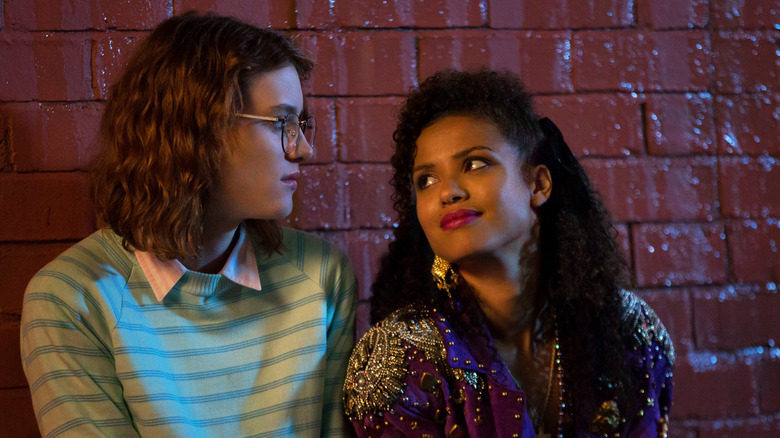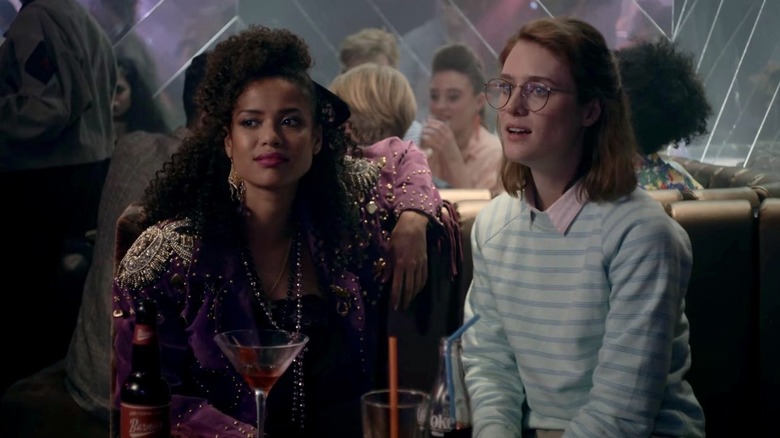Black Mirror's Creator Cut An Extremely Dark Scene From San Junipero
To this day, season 3's "San Junipero" still reigns high on most top 10 episode lists for "Black Mirror," and part of that's due to how uplifting it is. By this point in the show, the viewers had been trained to expect the worst, so the big twist here was that there isn't a twist at all: the heaven-esque simulation Kelly (Gugu Mbatha-Raw) and Yorkie (Mackenzie Davis) are living in is not a trap. It is a genuinely impressive experience of an idyllic afterlife, something that most of us would happily sign up for if given the opportunity.
The episode's closing montage is one of Yorkie and Kelly embracing their digital afterlife in 1980s San Junipero, while shots of the simulation computer help to emphasize just how strange (and miraculous) this opportunity is for them. Will this happiness eventually turn to boredom? Probably, but for Yorkie (who spent most of her real life paralyzed and trapped with her homophobic family), at least technology's given her a chance at happiness in the first place.
Because "San Junipero" only focuses on Kelly and Yorkie, fans have often wanted the show to return to the premise to observe it from a different angle. What's the afterlife like for the other digital residents here? What other ways is this technology being used? In the original draft for the episode, there was a small scene shedding some extra light on these questions. As creator Charlie Brooker explained in a 2017 interview:
"There were aspects of the story that I took out. For instance, I'd originally written a scene where Gugu's character, Kelly, is in a kindergarten and there are children there and when you realize what's going on, it's that these are deceased children. It was too sad and too poignant of a note to hit in that story, but I kept thinking about how that felt like a whole world in and of itself. I think we almost might do it in a completely different form if we were doing a straight sequel, if that makes sense. Maybe not even as a normal episode."
Exploring the digital consciousnesses of dead children: dark, but fascinating
It's understandable why such a scene was cut. Not only does it sound tonally jarring, as Brooker said, but it would've messed with the episode's pacing. The Netflix seasons of "Black Mirror" have often been criticized for how indulgent in runtime they've gotten, but "San Junipero" is one of the few that get in and out quickly. Still, it's hard not to wonder about those digital children we never got to see. Do their brains still develop in San Junipero? Will they grow into adulthood in the digital world, or are they suck as kindergarteners forever?
Nine years after the episode aired, "Black Mirror" still hasn't offered that follow-up to "San Junipero" Brooker was musing about. However, that's not to say the concept behind the episode was never explored. "USS Callister," for instance, also puts its characters in a digital world where everything feels realistic. The idea of a digital afterlife was also somewhat touched on in season 2's "White Christmas" and season 4's "Black Museum." There, criminals had their consciousnesses downloaded into a digital world, not so they could enjoy the afterlife but so they could be tortured for all eternity.
It's telling that in almost all the other occasions of "Black Mirror" exploring the idea of digital consciousness, the outcomes have been negative. But in hindsight, that only makes the magic of "San Junipero" hit even harder. Everything we know about this sort of technology implies a catch: that Kelly and Yorkie are dooming their souls by agreeing to take part in something that promises so much. But for once in "Black Mirror," things turn out alright. Kelly and Yorkie get their happy ending, something barely anyone on this show ever gets to enjoy.

